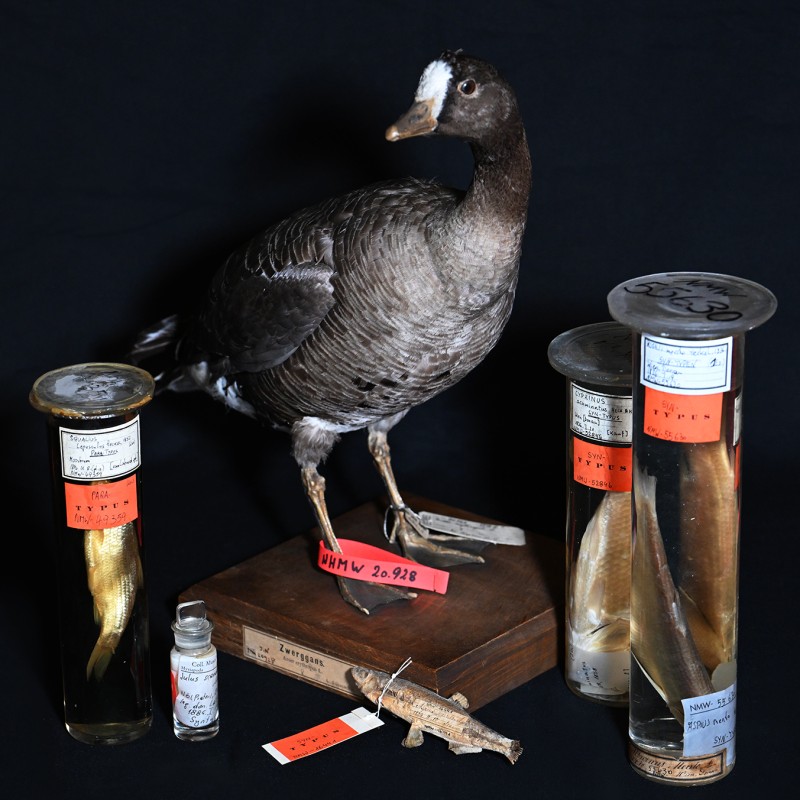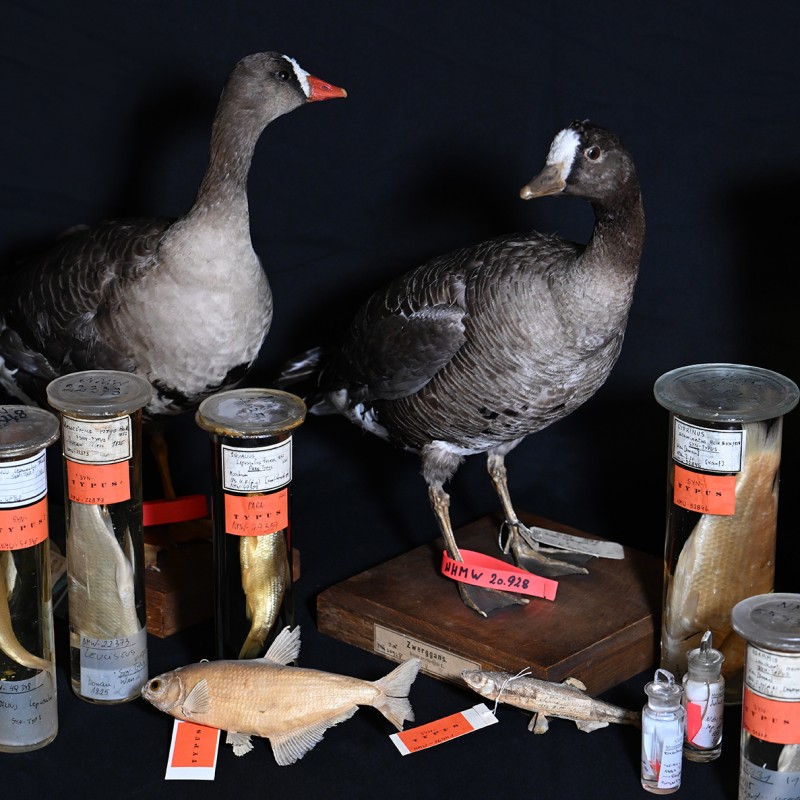So-called "Viennese types"
19. December 2023
What do four millipedes, two
grasshoppers, three parasite species, a goose and twelve fish have in common? They are all presumed to be type specimens from
Vienna!
The classification of biological species provides the basis for understanding biodiversity. Knowing which species of plants, animals, fungi and microorganisms one is dealing with is indispensable for many areas of research.
The classification of biological species provides the basis for understanding biodiversity. Knowing which species of plants, animals, fungi and microorganisms one is dealing with is indispensable for many areas of research.
You can only protect the things you know
At the Natural History Museum Vienna, the role of taxonomists is to classify and name organisms.
Taxonomists seek to organise and structure the diversity of life. Organisms are classified into groups or categories based on common characteristics and natural kinship. This classification can be conducted at various levels, from very basic categories such as “the animal kingdom” to specific groups such as a particular genus or species.
Regardless of whether one deals with insects, birds or mammals, there must be one specimen that one can use to identify a species and distinguish it from other species or subspecies. Against the backdrop of the current destruction of ecosystems and the associated extinction of species, the description of species has taken on particular importance.
This description is based on one or more individuals collected at a specific location (type locality). It goes without saying, that quite a number of species found in Vienna were described for the first time at the NHM Vienna.
Given that the Natural History Museum Vienna is not only an exhibition space, but also conducts research with a focus on taxonomy, a particularly large number of so-called type specimens are kept here. Valuable for scholarly research, these objects are the reference specimens for the description of a species or genus and are marked in the collections with a red band or red plates. Featuring rarely in exhibitions, types are used exclusively for scholarly work. They must be available as physical specimens in the research centres and be publicly accessible, because if a researcher were to pick up a beetle they cannot classify, for instance, the taxonomists in natural history museums can help and identify the species. If the taxonomists do not know either and a literature search does not provide any clues, it is almost certainly a new species that needs to be described and named.
As a rule, species are described according to their appearance and external characteristics. In recent years, a more innovative approach has been to identify species using genetic data. ABOL (Austrian Barcoding of Life) is a research initiative at the NHM Vienna whose long-term goal is to create DNA barcodes of all animal, plant and fungal species in Austria.
It is often a challenge to make DNA analyses of Viennese type specimens, i.e. types found in Vienna, because they are historical specimens. The analysis of such old material requires special methods and a great deal of experience in handling the tissue, which is usually poorly preserved.
It is quite often the case that when confronted with similar species, the external characteristics on their own will not allow reliable conclusions as to which species they are. In such cases, genetic analyses are vital in order to distinguish these so-called "cryptic species”.
A project funded by the University Jubilee Foundation of the City of Vienna under the lead of Priv.-Doz. Dr Anja Palandačić, Collection Manager of the NHM Vienna's fish collection, now seeks to use new analyses to confirm the species status of a number of Vienna types, and perhaps even furnish a number of surprises!
At the Natural History Museum Vienna, the role of taxonomists is to classify and name organisms.
Taxonomists seek to organise and structure the diversity of life. Organisms are classified into groups or categories based on common characteristics and natural kinship. This classification can be conducted at various levels, from very basic categories such as “the animal kingdom” to specific groups such as a particular genus or species.
Regardless of whether one deals with insects, birds or mammals, there must be one specimen that one can use to identify a species and distinguish it from other species or subspecies. Against the backdrop of the current destruction of ecosystems and the associated extinction of species, the description of species has taken on particular importance.
This description is based on one or more individuals collected at a specific location (type locality). It goes without saying, that quite a number of species found in Vienna were described for the first time at the NHM Vienna.
Given that the Natural History Museum Vienna is not only an exhibition space, but also conducts research with a focus on taxonomy, a particularly large number of so-called type specimens are kept here. Valuable for scholarly research, these objects are the reference specimens for the description of a species or genus and are marked in the collections with a red band or red plates. Featuring rarely in exhibitions, types are used exclusively for scholarly work. They must be available as physical specimens in the research centres and be publicly accessible, because if a researcher were to pick up a beetle they cannot classify, for instance, the taxonomists in natural history museums can help and identify the species. If the taxonomists do not know either and a literature search does not provide any clues, it is almost certainly a new species that needs to be described and named.
As a rule, species are described according to their appearance and external characteristics. In recent years, a more innovative approach has been to identify species using genetic data. ABOL (Austrian Barcoding of Life) is a research initiative at the NHM Vienna whose long-term goal is to create DNA barcodes of all animal, plant and fungal species in Austria.
It is often a challenge to make DNA analyses of Viennese type specimens, i.e. types found in Vienna, because they are historical specimens. The analysis of such old material requires special methods and a great deal of experience in handling the tissue, which is usually poorly preserved.
It is quite often the case that when confronted with similar species, the external characteristics on their own will not allow reliable conclusions as to which species they are. In such cases, genetic analyses are vital in order to distinguish these so-called "cryptic species”.
A project funded by the University Jubilee Foundation of the City of Vienna under the lead of Priv.-Doz. Dr Anja Palandačić, Collection Manager of the NHM Vienna's fish collection, now seeks to use new analyses to confirm the species status of a number of Vienna types, and perhaps even furnish a number of surprises!



